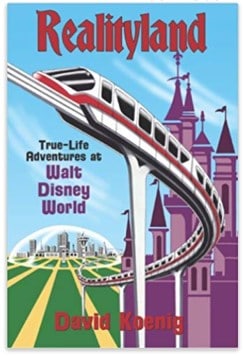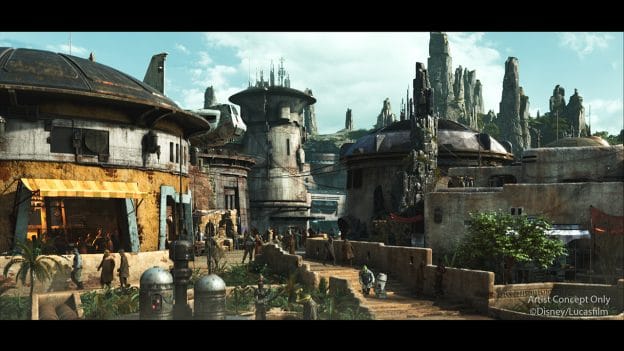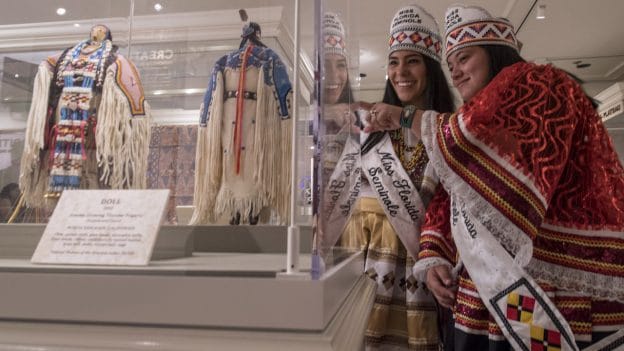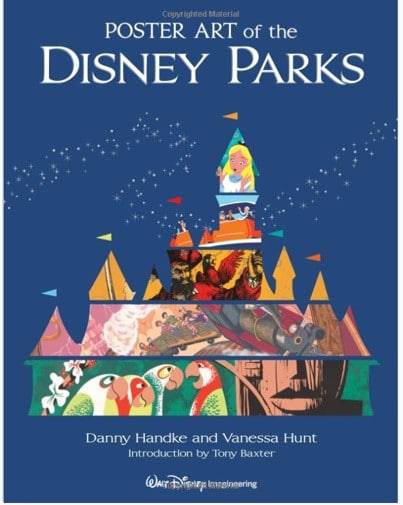Category — A Friday Visit with Jim Korkis
A Friday Visit with Jim Korkis: The Black Spire Cantina in Galaxy’s Edge
Welcome back to Fridays with Jim Korkis! Jim, the dean of Disney historians, writes about Walt Disney World history every Friday on yourfirstvisit.net.
THE BLACK SPIRE CANTINA
By Jim Korkis
The official description by Imagineering of Batuu, the setting of the new Star Wars: Galaxy Edge land at Disney’s Hollywood Studios, expected to open in the fall or late fall of 2019, is “Located on the edge of wild space, this remote outpost is home to all those who are seeking adventure and opportunity – pilots, smugglers, rogue traders and bounty hunters traveling between the frontier and uncharted space. This thriving space port is also a convenient safe haven for all others hoping to avoid the expanding reach of the First Order.”
Thousands of years ago, Batuu was known for the huge ancient trees that dotted its landscape, and as the trees evolved and petrified, those spires remained a distinctive feature of the planet.
There’s one particular spire that was blacker than the rest, and as bounty hunters and traders came to the area, they used it as an identifying marker for where to meet and do business, so the outpost sprang up around it.
Black spires are also found elsewhere in the Star Wars universe. In the movie Solo: A Star Wars Story, L3-37 mentions to Lando Calrissian that without her, he would not get from “here to the Black Spire Station.”
Of course, all these scoundrels and rogues would need a particular gathering spot to plot and plan, relax and tell tales of adventure. For Black Spire Outpost that will be Oga’s Cantina, which will serve pilots, bounty hunters, smugglers, locals and galactic travelers alike.
Portfolio Creative Executive, Walt Disney Imagineering Scott Trowbridge, stated that the Cantina, hosted by the alien proprietor, Oga Garra, will serve a mixture of drinks with choices for kids and adults, and to expect some of those otherworldly concoctions to have exotic ingredients prepared with unique methods and served in unique vessels.
Trowbridge elaborated that the creative team is “developing a specialty cocktail (non-alcohol- and alcohol-based) menu that will include creatively themed custom cocktails, and proprietary beer and wine options.” So it will serve more than the infamous and familiar blue milk.
The proprietor of the cantina is Oga Garra, an alien who “adheres to a strict code of conduct that tries to keep its unruly patrons in check.”
The cantina will feature music from a galaxy far, far away, courtesy of RX-24, a former StarSpeeder 3000 pilot droid that will seem familiar as the nervous and possibly defective “Rex” to fans of the original Star Tours. He’s found a new job as the cantina’s DJ. RX-24 will supposedly be as quirky and talkative as ever, and will probably be a better fit for a cantina rather than piloting tourists through the universe. Trowbridge said, Rex is “still trying to do his best on the job.”
Visitors to Oga’s Cantina will encounter some of the galaxy’s more interesting and disreputable characters, from First Order Stormtroopers, aliens, droids, and bounty hunters to more familiar Star Wars characters including some who are trying to hide from detection. However, these interactions will be random, without a set show schedule.
Visiting something like the Mos Eisley cantina first seen in George Lucas’ 1977 film Star Wars (now named Star Wars: A New Hope), has been something many Star Wars fans have always wanted to do, and now with the opening of the new land, they will finally get their chance.
* * * * *
Thanks, Jim! And come back next Friday for more from Jim Korkis!
In the meantime, check out his books, including his latest, The Vault of Walt Volume 7: Christmas Edition, and his Secret Stories of Walt Disney World: Things You Never You Never Knew, which reprints much material first written for this site, all published by Theme Park Press.
Follow yourfirstvisit.net on Facebook or Twitter or Pinterest!!
January 25, 2019 No Comments
A Friday Visit with Jim Korkis: “Creating Tradition” in the American Adventure Gallery
Welcome back to Fridays with Jim Korkis! Jim, the dean of Disney historians, writes about Walt Disney World history every Friday on yourfirstvisit.net.
CREATING TRADITION, INNOVATION AND CHANGE IN AMERICAN INDIAN ART
By Jim Korkis
Is it ever correct these days to use the term “American Indian” instead of “Native American?” That was the question faced by Disney when it was preparing the newest exhibition to be showcased in the American Heritage Gallery in Epcot’s World Showcase, “Creating Tradition: Innovation and Change in American Indian Art.”
One of Disney’s partners in putting together the exhibition was the Smithsonian’s National Museum of the American Indian. That organization determined that the term “American Indian” was appropriate for this particular exhibit in order to be consistent with what was being displayed.
The other partner collaborating for “Creating Tradition: Innovation and Change in American Indian Art” was the Museum of Indian Arts and Culture. in Santa Fe, New Mexico, and they also agreed on the terminology. Actually both terms are acceptable in the academic world, although it is considered better to use the name of the specific tribal nation.
On July 27, 2018, the all-new exhibition opened featuring artifacts from American Indian communities, with a special dedication from the Florida Seminole Tribe. This exhibition highlights the importance of traditional Native culture in contemporary American Indian art.
“Creating Tradition” showcases authentic, historical Native artifacts alongside contemporary works of American Indian art, demonstrating examples of cultural traditions which have been handed down through the generations.
Why did the former exhibit, the “Kinsey Collection” go away? As is often the case, the items featured in the exhibit were on loan for a specific amount of time.
After a five-year agreement with the Kinsey Family, the American Heritage Gallery inside the American Adventure pavilion was updated with a new display, as always planned. In general all the galleries at Epcot rotate out their exhibits every three to five years.
The 89 pieces on display at Creating Tradition: Innovation and Change in American Indian Art represent 40 different American Indian tribes from seven geographic regions across the United States.
“At Epcot, guests are invited to celebrate the limitless possibilities of human imagination and innovation.” said Melissa Valiquette, vice president of Epcot. “By showcasing artwork from so many diverse American Indian tribes, ‘Creating Tradition’ is a wonderful way to share a vital part of the United States’ culture with all those who visit The American Adventure.”
Collection highlights include:
- Fashion designer Loren Aragon (Acoma Pueblo) used the patterns on a jar made in the 1900s by an Acoma Pueblo potter as inspiration for his “Ancient Resonance” dress.
- A Pokagon Potawatomi black ash hamper basket, made in the early 1900s, is paired with modern baskets, exemplifying how this technique is maintained over centuries. For example, on display is “Mother’s Womb,” a basket made by Cherish Nebeshanze Parrish (Potawatomi/Odawa) in 2011.
- A Chilkat blanket from Alaska dating to the 1890s complements “Raven and the Box of Daylight,” a 2017 glass sculpture by Preston Singletary (Tlingit). This piece shows how Singletary experiments with designs from his Tlingit heritage in mediums beyond traditional Native materials.
Among the other featured artists with works on display are noted doll maker Glenda McKay (Ingalik-Athabascan), and Juanita Growing Thunder (Assiniboine Sioux) from the Growing Thunder family of Montana.
“Creating Tradition” also offers three interactive video exhibits where contemporary American Indian artists share perspectives on their work and culture. When guests wave their hands in front of a display resembling a campfire, the “flames” transform into a video presentation. Music playing in the gallery, performed by Native musicians, supports the objects and regions represented throughout the exhibition.
“I am delighted to recognize this association with Disney as their leadership shares the vision and creativity of contemporary American Indian artists with international visitors,” said Kevin Gover (Pawnee), director of the National Museum of the American Indian. “We hope Epcot visitors will see the American experience begins with the American Indians who have always been here.”
* * * * *
Thanks, Jim! And come back next Friday for more from Jim Korkis!
In the meantime, check out his books, including his latest, The Vault of Walt Volume 7: Christmas Edition, and his Secret Stories of Walt Disney World: Things You Never You Never Knew, which reprints much material first written for this site, all published by Theme Park Press.
Follow yourfirstvisit.net on Facebook or Twitter or Pinterest!!
January 18, 2019 No Comments
A Friday Visit with Jim Korkis: Poster Art of the Disney Parks
Welcome back to Fridays with Jim Korkis! Jim, the dean of Disney historians, writes about Walt Disney World history every Friday on yourfirstvisit.net.
YOUR PERSONAL DISNEY LIBRARY (13)
By Jim Korkis
- Poster Art of the Disney Parks by Danny Handke and Vanessa Hunt
Released in 2012 by Disney Editions, Poster Art of the Disney Parks is still a popular seller because it is timeless. At roughly eleven and half by fourteen and a half inches, the pages are large enough so that even when there are several images on an individual page they still are big enough to be seen clearly and when there is only one, it is spectacular.
Both Handke and Hunt are Imagineers who specialize in artwork, so it is not surprising that this is a beautifully done book when it comes to displaying art. However, while the focus is on the art, there is still plenty of room for explanatory text, although, as always, I would have liked even more including background on some of the talented artists.
After an informative introduction by Imagineer Tony Baxter, there are nine chapters: Here You Leave Today…, Main Street, U.S.A., Adventureland, New Orleans Square and Liberty Square, Frontierland, Fantasyland, Tomorrowland, Tokyo DisneySea, and Disney California Adventure. The book ends with a bibliography and an index by artist.
For Walt Disney World fans, it is interesting to compare the Disneyland and Walt Disney World posters for the same attraction like The Enchanted Tiki Room and the Tropical Serenade. Also, there are several examples of posters of attractions that are uniquely Disney World, like The Hall of Presidents
In the summer of 1956, Disneyland sported an exciting new visual method to entice guests to unfamiliar at the time Disneyland attractions, exhibits and restaurants: brightly silk screened framed attraction posters adorned the area below the Main Street Train Station at the entrance of the park, the Penny Arcade, and also the distinctive Avenue of the Flags entrance in Tomorrowland.
Later in 1959, the posters would decorate the bottom of the monorail support pylons. Walt Disney considered his theme park analogous to a motion picture experience, so these posters served as “Coming Attractions” posters like at a movie theater to excite and familiarize guests with what “shows” were in the park.
The early posters with their simple but dramatic graphics were intentionally designed with limited blocks of color to keep the silk-screen process uncomplicated. Disneyland used silk-screening to render each poster, but Walt Disney World favored a 4-color lithography process even when the artwork was basically the same.
Over the years, talented Disney Imagineers designed attraction posters, including Claude Coats (Alice in Wonderland), Rolly Crump (Flying Saucers) and Mary Blair (“it’s a small world”). Between 1956 and 1987, 32 different ride posters were created by Disney artists on large masonite panels that were used as the model for the finished silk-screened print.
As the park evolved, certain attraction posters, like the one for the Monorail (done by Paul Hartley), required updated images or text and a new version of the poster was made.
A great site for more information about Disney park posters is here.
I know some Disney fans who bought two copies of this book so they could use a razor blade and remove some of the full-sized pages to frame in their houses. I am not quite that fanatical although I have purchased some full sized reproductions at the Art of Disney Gallery at WDW for a similar purpose.
* * * * *
Thanks, Jim! And come back next Friday for more from Jim Korkis!
In the meantime, check out his books, including his latest, The Vault of Walt Volume 7: Christmas Edition, and his Secret Stories of Walt Disney World: Things You Never You Never Knew, which reprints much material first written for this site, all published by Theme Park Press.
Follow yourfirstvisit.net on Facebook or Twitter or Pinterest!!
January 11, 2019 No Comments
A Friday Visit with Jim Korkis: Harper’s Mill
Welcome back to Fridays with Jim Korkis! Jim, the dean of Disney historians, writes about Walt Disney World history every Friday on yourfirstvisit.net.
HARPER’S MILL ON TOM SAWYER ISLAND
By Jim Korkis
While the man-made Tom Sawyer Island was completed before the Magic Kingdom opened in October 1971, it would not open to the public until May 20, 1973. It is the one of the few locations at WDW that has changed relatively little since it first opened.
The interior of the island feels very much like a wilderness that encouraged exploration, with the indications of civilization like Aunt Polly’s house and Harper’s Mill placed along the shoreline facing Frontierland and the steamboat.
Of course, the island was inspired by a similar location at Disneyland that has since significantly changed, but also originated as a representation of Walt Disney’s rustic boyhood and his dreams of adventure.
One of the significant landmarks on the island is Harper’s Mill. (Disneyland’s Harper’s Cider Mill was changed to Lafitte’s Tavern in 2007.)
Outside the Walt Disney World building, a sign supposedly scrawled by a young Tom Sawyer himself states: “This here deserted grist mill wuz (sic) named after my frien (sic) Joe Harper’s old man. If ‘n’ you chooze (sic) to go inside, please don’t scare the birds that you will find there unless some no good done scared ‘em before you did.”
The mill represents a working grain mill of the sort that used to be quite common on the Mississippi River. In Mark Twain’s novel, Tom and his friend Huck Finn ran away and accompanying them was another boy, Joe Harper. According to the sign, the mill belonged to his father.
However, if you talk with Imagineers who worked on the park, the name of the mill (like the one at Disneyland) was meant to be a tribute to Imagineer Harper Goff, who contributed so much to the design of Frontierland at both Disneyland and Walt Disney World. As with much of WDW history that was just passed along orally rather than being officially written down, it is almost impossible to verify whether this is true.
What is indisputably true is that inside Harper’s Mill is a tribute to the Disney Academy Award winning animated short The Old Mill (1937), the first cartoon to make use of the multiplane camera. In the cartoon, animals seek refuge from a thunderstorm inside an abandoned, decrepit old mill.
In the short, one of the bottom sockets in the gear has become a temporary home for a mother bluebird and her eggs. However as the storm rages, the wind causes the gear to start to turn and now those eggs are in danger of being crushed by an upper prong from another gear as they join together. Luckily that upper gear is missing one of its teeth and so disaster is averted after several tense moments.
The Walt Disney World mill looks nothing like the one in the cartoon (and is attached to a waterwheel rather than a windmill), and even the interior gear configuration is different, but there is no mistake that this was a conscious nod to the film.
Looking upwards, guest will see an owl similar to the one in the cartoon and sitting in her nest in the socket hole is the blue bird. As an added treat, as the gears move, the Imagineers have the gears “creak” to the tune of the classic song Down by the Old Mill Stream.
* * * * *
Thanks, Jim! And come back next Friday for more from Jim Korkis!
In the meantime, check out his books, including his latest, The Vault of Walt Volume 7: Christmas Edition, and his Secret Stories of Walt Disney World: Things You Never You Never Knew, which reprints much material first written for this site, all published by Theme Park Press.
Follow yourfirstvisit.net on Facebook or Twitter or Pinterest!!
January 4, 2019 No Comments
A Friday Visit with Jim Korkis: Realityland
Welcome back to Fridays with Jim Korkis! Jim, the dean of Disney historians, writes about Walt Disney World history every Friday on yourfirstvisit.net.
YOUR PERSONAL DISNEY LIBRARY (12)
By Jim Korkis
- Realityland: True-Life Adventures at Walt Disney World, by David Koenig
David Koenig has been a columnist writing about Disney for over two decades, as well as the author of several Disney related books including Mouse Tales: A Behind the Scenes Look at Disneyland and its sequel.
In 2007, he decided to tackle the daunting task of documenting Walt Disney World and interviewed over a hundred past and present cast members to try to get an in-depth perspective.

Interestingly, the latter chapters showcase less of other people’s memories, and Koenig seems to do more of his own personal summary to rush to the end of the story.
Koenig can not be faulted that there was so much to cover even in a book that is over three hundred pages that some items seem to get much less attention. He does not shy away from revealing some of the negative aspects and missteps of Disney in Florida. I know some people relish hearing about the “darker side” of Disney but I feel Koenig, for the most part, was justified in order to show the difficulties of building the vacation destination and is not unfair when he covers that material.
For the most part, Koenig’s work is accurate but there are occasional slips throughout the text like claiming Walt was working on the St. Louis Riverfront Square project “by 1960” when the city fathers did not even approach Walt until 1963 and it wasn’t until March 1964 that Walt announced his proposal for that indoor amusement venue.
Nor does Koenig point out how work on that project that ended in July 1965 ended up influencing aspects of Florida’s Magic Kingdom and increased Florida’s willingness to work with Disney seeing how easily he walked away from St. Louis when they didn’t give him what he wanted. Yet these minor “speed bumps” do not detract from the main thrust of the text.
Koenig also tends to trust the quotes he got from his interview subjects without doing sufficient cross checking to confirm their accounts. I have found that sometimes interview subjects are not always accurate on chronology and proper nomenclature, maybe only saw their part of a much larger project or sometimes have an agenda they wish to promote about their accomplishments or to grind axes about old enemies.
Koenig’s strength, as in his previous books, is preserving some of the many stories surrounding Walt Disney World and I smiled broadly at his recounting of his first visit to the now extinct Big Bamboo Lounge, a seedy bar hangout for vintage WDW cast members for years, because it mirrored my own first visit so closely.
One of the original WDW cast members, Bill Hoelscher, seems to be a major contributor and his perspective of the time has been sadly neglected in other works about WDW. In fact, Koenig went beyond “the same usual suspects” in gathering material for this book and I am grateful he did.
With so few books available solely about Walt Disney World, this is definitely one of the better ones available. Perhaps the strongest criticism I have is that I wish Koenig had written even more or produced a sequel volume like he did for his look at Disneyland but concentrating on the last half of the story that he had to quickly skim over here. Koenig’s writing is clear and he did a good job of juggling so much material and still maintaining an understandable narrative.
* * * * *
Thanks, Jim! Realityland is one of the first books I read about Disney World, and I thought it was a hoot! The stories about Epcot especially remain with me.
And come back next Friday for more from Jim Korkis!
In the meantime, check out his books, including his latest, The Vault of Walt Volume 7: Christmas Edition, and his Secret Stories of Walt Disney World: Things You Never You Never Knew, which reprints much material first written for this site, all published by Theme Park Press.
Follow yourfirstvisit.net on Facebook or Twitter or Pinterest!!
December 28, 2018 No Comments
A Friday Visit with Jim Korkis: Prep & Landing
Welcome back to Fridays with Jim Korkis! Jim, the dean of Disney historians, writes about Walt Disney World history every Friday on yourfirstvisit.net.
A PREP & LANDING CHRISTMAS
By Jim Korkis
Once again this year, WDW guests can experience the nighttime event Jingle Bell, Jingle BAM! at Disney’s Hollywood Studios. However, some guests may be unaware of the origins of Santa’s elves, Wayne and Lanny, who are part of the Prep & Landing crew.
Walt Disney Animation Studios wanted to revive original seven minute shorts to precede Disney theatrical features and the first one was How to Hook Up Your Home Theater with an inept Goofy released in 2007.

“Chris Williams was the one who initially dreamed up the idea of this elite group of elves who each year help get houses ready for Santa’s arrival. And when Chris got too busy directing Bolt (2008) to do Prep and Landing, John Lasseter turned to Stevie (Wermers-Skelton) and I and asked if we’d be interested in developing Chris’s idea,” said co-writer and co-direct of Prep & Landing Kevin Deters.
“Chris had already created the characters of Lanny, the excited rookie, and Wayne, the jaded veteran. But that was just for the seven-minute-long short version of Prep & Landing. We were looking to tell a far bigger story with these characters. So we worked closely with John to expand our storyline, flesh out the world of the North Pole and these elves.”
The first Prep & Landing television half hour special was released in December 2009. It won several Annie and Emmy awards. It was followed by a seven minute short in 2010 called Operation: Secret Santa and by another half hour special in 2011. Prep & Landing: Naughty vs. Nice also garnered Annie and Emmy awards but failed to attract as large an audience as expected resulting in the cancellation of a third half hour special.
To help promote the new Naughty vs. Nice special, an eight page comic book (Mansion: Impossible!) story of Wayne and Lanny preparing Marvel’s The Avengers’ Mansion appeared as a back-up story in the “all ages” editions meant for younger readers of Marvel Adventures Avengers #19, Marvel Adventures Super-Heroes #20, and Marvel Adventures Spider-Man #20.
It was written by Deters and drawn by Joe Mateo, who had received an Emmy Award as a storyboard artist for his work on the first special and also storyboarded the second special as well.
The Jingle Bell, Jingle BAM! holiday fireworks show began at Disney’s Hollywood Studios in 2016 and has continued to run each year during the Christmas season festivities after that. Wayne and Lanny conduct a search-and-rescue mission to return Santa to the North Pole in time for Christmas. Oogie Boogie from The Nightmare Before Christmas film has kidnapped Santa Claus and Wayne and Lanny eventually rescue the Big Guy.
The show is a combination of state-of-the-art projections on the Chinese Theater along with lasers and lights, special effects (snow falling at the conclusion) and a fireworks finale which is the “BAM!”.
It also includes montage scenes from several Disney animated films including Mickey’s Christmas Carol, Beauty and the Beast, Pluto’s Christmas Tree, Bambi, Tim Burton’s The Nightmare Before Christmas and many more as backdrop to various standard Christmas songs interspersed with brief segments of Wayne and Lanny trying to find and rescue Santa.
Wayne and Lanny have also made appearances in digital windows from 2011 – 2015 at Walt Disney World’s former Osborne Family Spectacle of Dancing Lights, and in a specially animated two minute pre-show segment for Disney’s California Adventure night time water spectacular show World of Color during the holiday season from 2011-2013.
* * * * *
Thanks, Jim! For more on Jingle Bell, Jingle BAM!, see this.
And come back next Friday for more from Jim Korkis!
In the meantime, check out his books, including his latest, The Vault of Walt Volume 7: Christmas Edition, and his Secret Stories of Walt Disney World: Things You Never You Never Knew, which reprints much material first written for this site, all published by Theme Park Press.
Follow yourfirstvisit.net on Facebook or Twitter or Pinterest!!
December 21, 2018 2 Comments






